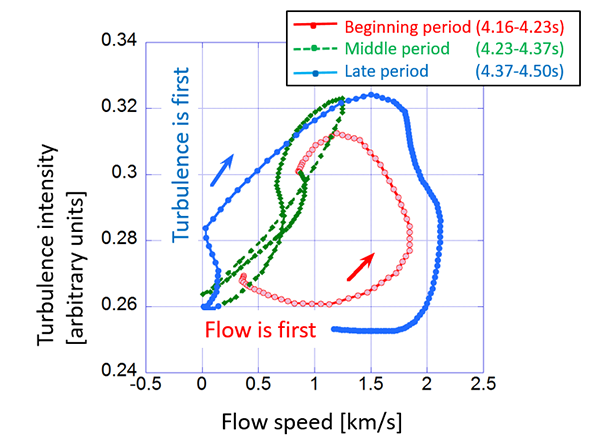HOME > Research Activities > Research Updates >
Recently, throughout Japan wild boars, or inoshishi, and other wild animals have been sighted and reported in the news. At the National Institute for Fusion Science, too, an adult and young inoshishi recently have been observed. Not only wild boars, but also deer, bears, and other mountain animals have been observed in increasing numbers in areas where humans reside. According to one explanation, when food in the mountains increases, the number of animals that eat such food increases. Conversely, it is believed that when the number of animals increases too greatly, they eat too much of the food and the supply falls, and then the number of animals falls. And when the number of animals falls, the amount of food increases. Such a relation is thought to be held. When the number of animals increases, animals appear in residential areas, and as a result the animals come into contact with people. In such an issue of causality, the problem of cause and effect, that is, which came first, the chicken or the egg, is also seen in the field of plasma physics and is debated among researchers. The issue here is which came first, “turbulence” or “flow”?
In a plasma confined by the magnetic field, similar to being in water, flow and turbulence appear. When turbulence is generated, a significant number of large eddies appear. This condition is called “turbulence.” As a result, plasma confinement deteriorates. This turbulence is thought to be suppressed by the “shear flow.” The shear flow is the flow that has both a fast flow and a slow flow. Depending upon the differences in the flow speed at a specific location, large eddies are extended and torn, and the turbulence is suppressed by tearing. On the other hand, from the turbulence itself, too, the flow generation is indicated theoretically. Due to this, when the turbulence becomes strong, flow accelerates. And when the flow becomes faster, this time the turbulence weakens.
Which is generated first, “turbulence” or “flow”?
When plasma confinement becomes improved, the plasma pressure becomes higher locally, and the pressure gradient nearby grows stronger. Thus, as with a river that follows the steep slope of a high mountain to flow fast, the plasma flow, too, grows faster. Then, because there are places where the pressure gradient is strong and where the pressure gradient is weak, shear flows occur with different speeds that depend upon the location. On the other hand, there are instances when the pressure gradient grows stronger, the plasma becomes unstable, and turbulence grows. That is, when plasma confinement improves and pressure gradient grows stronger, it is possible that both “flow” and “turbulence” will grow larger. Thus, we conducted experiments in the Large Helical Device (LHD) regarding which between flow and turbulence will grow first.
In order to investigate this issue, it is necessary to simultaneously measure both the strength of the plasma’s turbulence and the speed of the flow. In the LHD, recently, we developed the diagnostics equipment called a frequency comb. (For details, please see back number 296.) This diagnostic can measure simultaneously the strength of the turbulence as well as the direction and the magnitude of the flow in multiple places in the plasma. Thus, in the LHD, by controlling the heating power, we generated plasma that can move between good confinement condition (This is called H-mode. H indicates high.) and normal confinement condition (This is called L-mode. L indicates low.), and investigated characteristics of this plasma. Through research using different devices, we learned that when plasma becomes in the H-mode, the pressure gradient of the edge plasma grows stronger, and the shear flow grows larger. As results of this experiment in the LHD, we learned for the first time that when becoming the H-mode, both cases are possible in which the turbulence becomes strong first, and the flow accelerates first. Further, we learned that which of those two cases appears depends upon the timing of the discharge, and that plasma switches between two cases spontaneously. Moreover, when investigating the spatial structure, we learned that which of those two cases even depends upon the locations in the plasma, of which phenomenon exceeded our predictions. In this way, we are advancing in our research and aiming to clarify issues of the laws of causality regarding flow and turbulence that has been unsolved issues of plasma physics.

The temporal changes of intensity of the turbulence and the flow speed in the plasma.
We measured a plasma’s turbulence and its flow in a single location at three different time intervals. Each time interval is expressed in red, green, and blue lines. In the case of the red time interval, the flow is becoming stronger first. In the case of the blue time interval, the turbulence is growing stronger first. The plasma is conducting these changes spontaneously.
